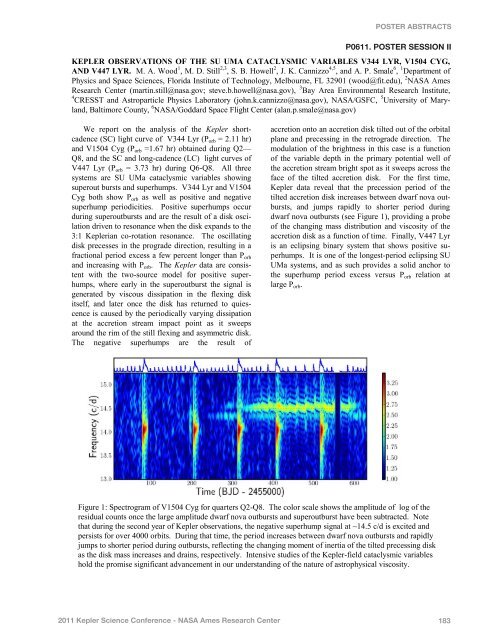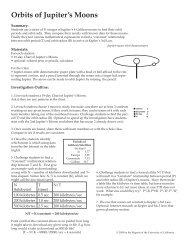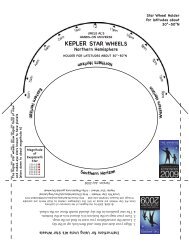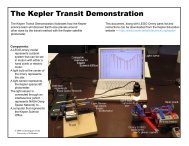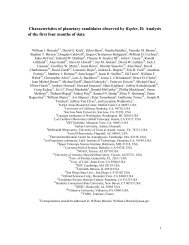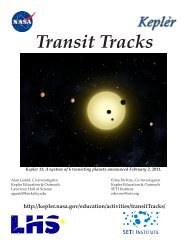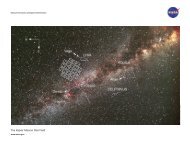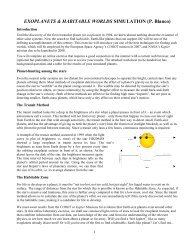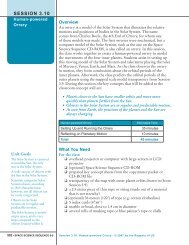Poster Abstracts - Kepler - NASA
Poster Abstracts - Kepler - NASA
Poster Abstracts - Kepler - NASA
- No tags were found...
Create successful ePaper yourself
Turn your PDF publications into a flip-book with our unique Google optimized e-Paper software.
POSTER ABSTRACTSP0611. POSTER SESSION IIKEPLER OBSERVATIONS OF THE SU UMA CATACLYSMIC VARIABLES V344 LYR, V1504 CYG,AND V447 LYR. M. A. Wood 1 , M. D. Still 2,3 , S. B. Howell 2 , J. K. Cannizzo 4,5 , and A. P. Smale 6 , 1 Department ofPhysics and Space Sciences, Florida Institute of Technology, Melbourne, FL 32901 (wood@fit.edu), 2 <strong>NASA</strong> AmesResearch Center (martin.still@nasa.gov; steve.b.howell@nasa.gov), 3 Bay Area Environmental Research Institute,4 CRESST and Astroparticle Physics Laboratory (john.k.cannizzo@nasa.gov), <strong>NASA</strong>/GSFC, 5 University of Maryland,Baltimore County, 6 <strong>NASA</strong>/Goddard Space Flight Center (alan.p.smale@nasa.gov)We report on the analysis of the <strong>Kepler</strong> shortcadence(SC) light curve of V344 Lyr (P orb = 2.11 hr)and V1504 Cyg (P orb =1.67 hr) obtained during Q2—Q8, and the SC and long-cadence (LC) light curves ofV447 Lyr (P orb = 3.73 hr) during Q6-Q8. All threesystems are SU UMa cataclysmic variables showingsuperout bursts and superhumps. V344 Lyr and V1504Cyg both show P orb as well as positive and negativesuperhump periodicities. Positive superhumps occurduring superoutbursts and are the result of a disk oscilationdriven to resonance when the disk expands to the3:1 <strong>Kepler</strong>ian co-rotation resonance. The oscillatingdisk precesses in the prograde direction, resulting in afractional period excess a few percent longer than P orband increasing with P orb . The <strong>Kepler</strong> data are consistentwith the two-source model for positive superhumps,where early in the superoutburst the signal isgenerated by viscous dissipation in the flexing diskitself, and later once the disk has returned to quiescenceis caused by the periodically varying dissipationat the accretion stream impact point as it sweepsaround the rim of the still flexing and asymmetric disk.The negative superhumps are the result ofaccretion onto an accretion disk tilted out of the orbitalplane and precessing in the retrograde direction. Themodulation of the brightness in this case is a functionof the variable depth in the primary potential well ofthe accretion stream bright spot as it sweeps across theface of the tilted accretion disk. For the first time,<strong>Kepler</strong> data reveal that the precession period of thetilted accretion disk increases between dwarf nova outbursts,and jumps rapidly to shorter period duringdwarf nova outbursts (see Figure 1), providing a probeof the changing mass distribution and viscosity of theaccretion disk as a function of time. Finally, V447 Lyris an eclipsing binary system that shows positive superhumps.It is one of the longest-period eclipsing SUUMa systems, and as such provides a solid anchor tothe superhump period excess versus P orb relation atlarge P orb .Figure 1: Spectrogram of V1504 Cyg for quarters Q2-Q8. The color scale shows the amplitude of log of theresidual counts once the large amplitude dwarf nova outbursts and superoutburst have been subtracted. Notethat during the second year of <strong>Kepler</strong> observations, the negative superhump signal at ~14.5 c/d is excited andpersists for over 4000 orbits. During that time, the period increases between dwarf nova outbursts and rapidlyjumps to shorter period during outbursts, reflecting the changing moment of inertia of the tilted precessing diskas the disk mass increases and drains, respectively. Intensive studies of the <strong>Kepler</strong>-field cataclysmic variableshold the promise significant advancement in our understanding of the nature of astrophysical viscosity.2011 <strong>Kepler</strong> Science Conference - <strong>NASA</strong> Ames Research Center 183


